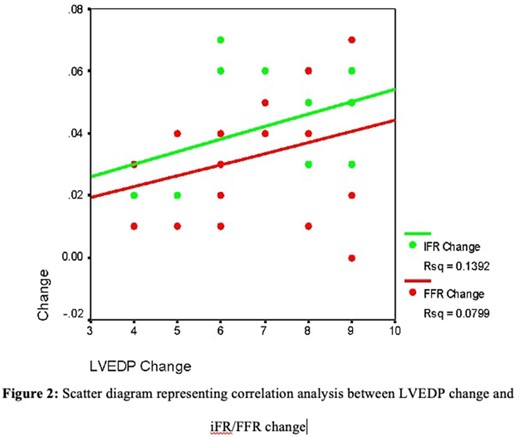-
PDF
- Split View
-
Views
-
Cite
Cite
P Sharma, S Vohra, M Bhandari, A Sharma, P Vishwakarma, G Chaudhary, A Pradhan, S Chandra, S K Dwivedi, R Sethi, Instantaneous wave-free ratio and fractional flow reserve: effect of variation in left ventricular end diastolic pressure, European Heart Journal, Volume 43, Issue Supplement_1, February 2022, ehab849.124, https://doi.org/10.1093/eurheartj/ehab849.124
Close - Share Icon Share
Abstract
Type of funding sources: None.
Among patients with intermediate coronary artery stenosis (50-90%), assessment of functional significance of the lesion by instantaneous wave free ratio (iFR)/ fractional flow reserve (FFR) is recommended in latest guidelines. Though iFR is not much affected by change in hemodynamics compared to FFR, the change in iFR vs FFR due to various hemodynamic factors need a validation. Left ventricular end-diastolic pressure (LVEDP) is one of the hemodynamic factors whose variation and effect on FFR vs iFR is largely unknown. In the present study we evaluated the association of change in LVEDP on the changing pattern of iFR/FFR which may hold a clinical significance especially with percutaneous coronary intervention in heart failure patients.
This was a prospective, investigator-initiated, single-center study involving 20 patients with stable coronary artery disease and at least one intermediate coronary lesion (50-90%). The enrolled patients were subjected to both iFR and FFR along with baseline LVEDP measurement. Subsequently, intravenous nitroglycerine infusion was given to reduce LVEDP and corresponding iFR and FFR were re-evaluated. The dynamic changes in iFR and FFR were studied in relation to changes in LVEDP using Pearson’s correlation analysis and linear regression analysis.
The mean LVEDP was lowered from 16.20 ± 1.54 mmHg to 9.50 ± 1.10 mmHg, the mean iFR and FFR got changed from 0.80 ± 0.12 to 0.76 ± 0.12 mmHg and 0.75 ± 0.09 to 0.72 ± 0.09 mmHg respectively. On Pearson’s correlation analysis, LVEDP change did not show statistically significant correlation (linear relationship) with iFR (p = 0.105, r2 = 0.373) and FFR (p = 0.227, r2 = 0.283) changes across the entire range of stenosis severity and in all vessels. Linear regression analysis did not state any independent correlation between LVEDP and iFR and FFR changes in the study group (p >0.05). The % R2 value for iFR and FFR (as a coefficient of determination) of the regression equation were 13.9% and 8%, which means only these percentages of the total variance in iFR and FFR change were explained by LVEDP changes respectively. There was no serious adverse event related to the procedure.

Abstract Figure. Box whisker plot
- nitroglycerin
- percutaneous coronary intervention
- coronary arteriosclerosis
- hemodynamics
- fractional coronary flow reserve
- heart failure
- left ventricle
- heterogeneity
- hypertension and diabetes
- constriction, pathologic
- vibrissae
- guidelines
- diastolic blood pressure
- left ventricular end-diastolic pressure level
- correlation studies
- coronary lesions
- linear regression
- adverse event
- infusion procedures
- coefficient of determination
- instantaneous wave-free ratio



